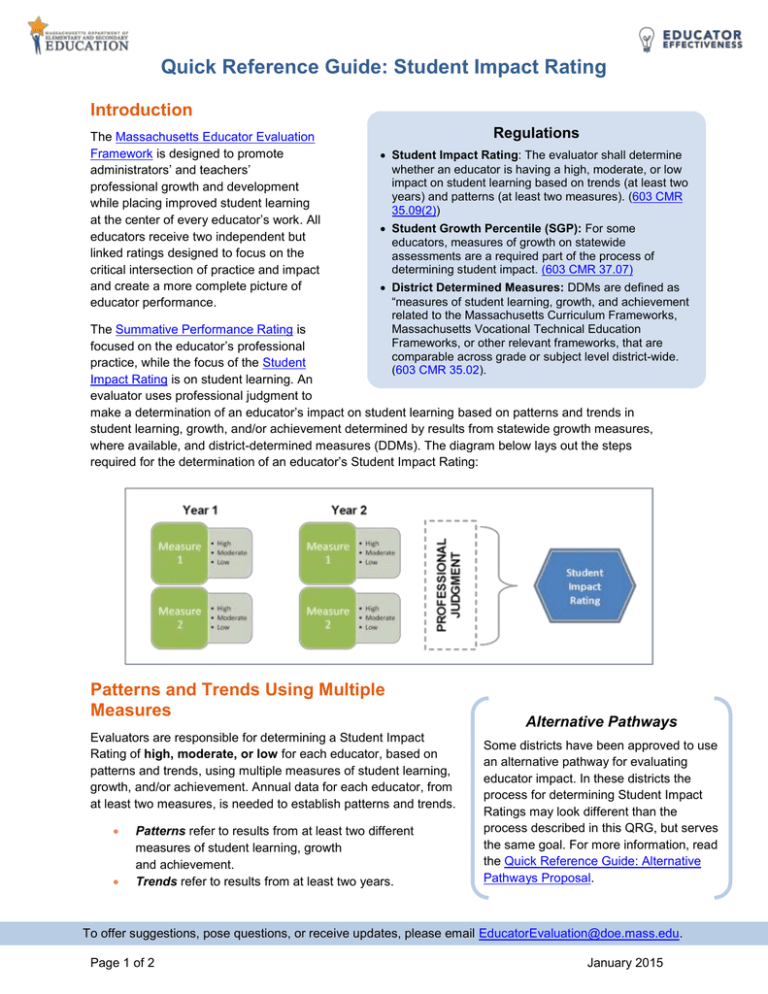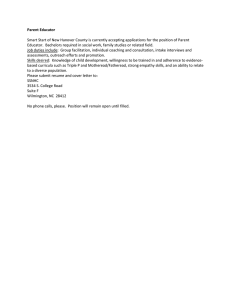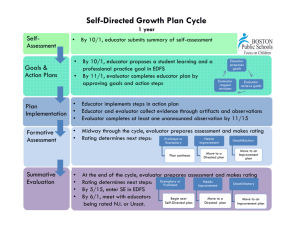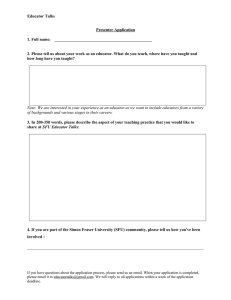QRG ImpactRating
advertisement

Quick Reference Guide: Student Impact Rating Introduction The Massachusetts Educator Evaluation Framework is designed to promote administrators’ and teachers’ professional growth and development while placing improved student learning at the center of every educator’s work. All educators receive two independent but linked ratings designed to focus on the critical intersection of practice and impact and create a more complete picture of educator performance. Regulations Student Impact Rating: The evaluator shall determine whether an educator is having a high, moderate, or low impact on student learning based on trends (at least two years) and patterns (at least two measures). (603 CMR 35.09(2)) Student Growth Percentile (SGP): For some educators, measures of growth on statewide assessments are a required part of the process of determining student impact. (603 CMR 37.07) District Determined Measures: DDMs are defined as “measures of student learning, growth, and achievement related to the Massachusetts Curriculum Frameworks, Massachusetts Vocational Technical Education Frameworks, or other relevant frameworks, that are comparable across grade or subject level district-wide. (603 CMR 35.02). The Summative Performance Rating is focused on the educator’s professional practice, while the focus of the Student Impact Rating is on student learning. An evaluator uses professional judgment to make a determination of an educator’s impact on student learning based on patterns and trends in student learning, growth, and/or achievement determined by results from statewide growth measures, where available, and district-determined measures (DDMs). The diagram below lays out the steps required for the determination of an educator’s Student Impact Rating: Patterns and Trends Using Multiple Measures Evaluators are responsible for determining a Student Impact Rating of high, moderate, or low for each educator, based on patterns and trends, using multiple measures of student learning, growth, and/or achievement. Annual data for each educator, from at least two measures, is needed to establish patterns and trends. Patterns refer to results from at least two different measures of student learning, growth and achievement. Trends refer to results from at least two years. Alternative Pathways Some districts have been approved to use an alternative pathway for evaluating educator impact. In these districts the process for determining Student Impact Ratings may look different than the process described in this QRG, but serves the same goal. For more information, read the Quick Reference Guide: Alternative Pathways Proposal. To offer suggestions, pose questions, or receive updates, please email EducatorEvaluation@doe.mass.edu. Page 1 of 2 January 2015 Quick Reference Guide: Student Impact Rating Statewide growth measures (e.g., median student growth percentiles (SGPs) from state assessments) must be used as one measure where available. However, these measures are only available for asmall percentage of educators. As a result, districts have identified or developed DDMs for most grades and subjects. For more information about DDMs, see the Quick Reference Guide on DDMs. Learn More About the Student Impact Rating Professional Judgment Rating Educator Impact: The Student Impact Rating Quick Reference Guide: District After patterns and trends of of student learning, growth, and/or Determined Measures achievement have been collected, evaluators will apply professional Implementation Brief: Using judgment to this evidence before assigning the Student Impact Student Growth Percentiles Rating. Evaluators are encouraged to bear in mind an educator’s student population and specific instructional context. Considerations related to a specific measure or a combination of measures may also factor into an evaluator’s determination of an educator’s Student Impact Rating. For specific examples of how instructional context, student population, and a consideration of measures can impact an evaluator’s application of professional judgment, see Appendix A of ESE’s Impact Rating Guidance. Student Impact Rating Reporting Starting with the 2015-16 school year, districts will report to ESE the Student Impact Ratings (high, moderate, or low) for all educators for whom patterns and trends have been established. Results from individual DDMs are not reported to ESE. Individual educator’s Student Impact Ratings, like all educator evaluation data submitted to ESE, are confidential and not subject to disclosure under public records law. For more information about reporting, read the Quick Reference Guide: Educator Evaluation Data Collection. Development of the Educator Plan The Summative Performance Rating and Student Impact Rating are used together to determine the type and length of an educator’s Educator Plan based on the table below. The Summative Performance Rating determines the type of plan and the Student Impact Rating may have a direct impact on the length of the plan. The Self-Directed Growth Plan is developed by the educator. The Directed Growth Plan is developed by the educator and evaluator and is one year or less in duration. The Improvement Plan is developed by the evaluator and is 30 days to one year in duration. The Developing Educator Plan applies to educators without Professional Teacher Status (PTS), administrators in their first three years in a district, or educators in new assignments (at the discretion of their evaluators). It is a one-year plan developed by the educator and evaluator. The diagram below illustrates the intersection of the Summative Performance Rating and Student Impact Rating. Performance Rating Exemplary Proficient 1-yr Self-Directed Growth Plan 2-yr Self-Directed Growth Plan Needs Improvement Directed Growth Plan Unsatisfactory Improvement Plan Low Moderate High Impact Rating To offer suggestions, pose questions, or receive updates, please email EducatorEvaluation@doe.mass.edu. Page 2 of 2 January 2015







